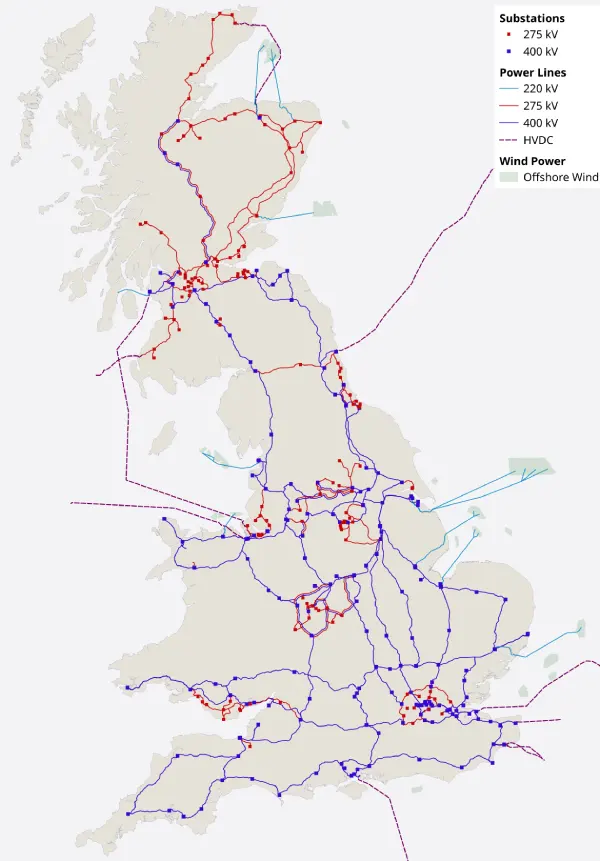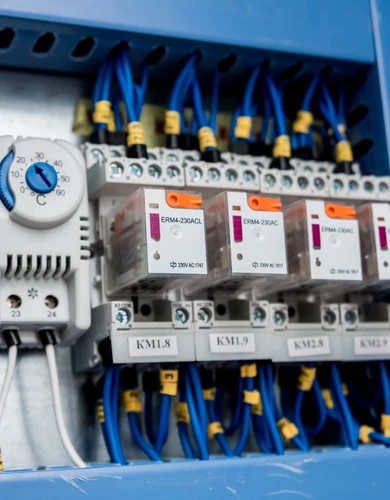The National Grid
The National Grid is the backbone of the UK’s electricity infrastructure, ensuring power flows seamlessly from generators to consumers across Great Britain.
Yet, ask anyone on the street what it is, and you’ll hear all sorts of answers! In this article, we explain its various meanings, break down its key components, and explain who the major players are involved in keeping the lights on across the country.
Contents
- What is the National Grid?
- How does the National Grid work?
- Who owns and operates the National Grid?
- How has the national grid changed over time?
What is the National Grid?
The National Grid is Great Britain’s high-voltage power transmission network, connecting power stations (e.g., Drax Power Station, Sizewell, Dogger Bank) with end-consumers (i.e., homes and businesses).
It comprises all overhead, underground and undersea high-voltage infrastructure crisscrossing England, Wales, and Scotland to transmit power over long distances through varied geographical terrain with minimal losses.
These cables culminate at various substations known as Grid Supply Points, which lower the voltage to safer levels before distributing the electricity to local distribution networks and end consumers.
Some terminals are extended internationally through cross-border interconnectors for electricity imports and exports to Europe or Ireland.
💡 Northern Ireland is not part of the “National Grid”. Instead, it has its own transmission system integrated into the Irish Single Electricity Market (SEM), which it shares with the Republic of Ireland.
What is meant by the National Grid?
The devolution of power to home nations and the privatisation of the electricity network have made a term as simple as the “national grid” ambiguous and with multiple meanings (capital letters do matter):
- The National Grid: The electricity generation, transmission and distribution network of Great Britain (England, Wales and Scotland).
- National Grid ESO: The principal operator of “The National Grid”. It ensures its efficient and safe operation and manages the wholesale electricity market. It is a semi-independent subsidiary of “National Grid Plc” regulated by Ofgem. National Grid ESO has recently rebranded to the “National Energy System Operator”.
- A national grid: The high-voltage distribution network of any nation. The Scottish “national grid” is often discussed as separate but is part of “The National Grid”, while the Northern Irish “national grid” is part of the larger Irish grid.
- National Grid Plc: A publically traded company that part-owns and part-operates the national grids of England and Wales only. It is the umbrella company for the National Grid ESO, the National Gas Transmission network, the HVDC and BritNed interconnectors.
How does the National Grid work?
The purpose of the National Grid is to distribute power from generators to consumers as efficiently as possible. Its working can be described through its key components:
These are the key components of the Great Britain National Grid:
- Power generators
- High-voltage transmission lines
- Substations
- Local distribution networks
- Interconnectors
1. Power generation
Large, GW-scale power stations (nuclear, gas, wind, etc) across the UK are the starting point for electricity generation. Once generated, electricity is fed directly onto high-voltage transmission cables, which constitute the ‘arteries’ of the national grid.
Smaller micro-generators (micro-hydro, solar, and wind) usually feed their electricity into local distribution networks and are usually consumed locally.
2. High-voltage transmission

The National Grid comprises nearly 10,000km of overhead, underground and underwater high-voltage cables, originating and culminating at one of approximately 450 transmission and regional substations distributed across England, Wales and Scotland.
These physical assets make up Britain’s long-distance power transmission network. They are owned and operated separately by three different TNOs (Transmission Network Operators), broadly divided into three regions:
- England & Wales: National Grid Electricity Transmission (Part of The National Grid Plc. Group).
- Southern & Central Scotland: Scottish & Southern Electricity Networks (SSE).
- Northern Scotland: Scottish Power Energy Networks (Scottish Power).
Each TNO owns its corresponding infrastructure:
| Asset | National Grid Plc (England & Wales) | SP (Southern & Central Scotland) | SSE (Northern Scotland) | Description |
|---|---|---|---|---|
| 400,000V (400 kV) Cables | 4,500 km | 2,000 km | 1,000 km | Highest voltage cables used for long-distance transmission. |
| 275,000V (275 kV) Cables | 2,700 km | 1,800 km | 1,000 km | High-voltage cables used in regional transmission networks. |
| Underground Cables | 1,500 km | 600 km | 200 km | High-voltage cables used in urban areas or environmentally sensitive regions. |
| Subsea Cables | 500 km | N/A | N/A | Cables connecting the UK to other countries, such as the UK-France and UK-Netherlands interconnectors. |
| Substations | 300 | 150+ | 100+ | Facilities where voltage is stepped down from high transmission levels to lower levels for distribution. |
Source: National Grid, SP Energy Networks
High-voltage transmission technology
The lines for this purpose operate at very high voltages, 275,000 or 400,000 volts, to make long-distance transmission more efficient.
Overhead power lines are the most visible part of the network, supported by iconic large pylons that traverse the countryside and urban areas. Underground cables are used in densely populated or environmentally sensitive areas where overhead lines are impractical or undesirable. Subsea cables, meanwhile, are employed to connect offshore UK wind farms or transmission via interconnectors.
All high-voltage transmission lines use modern conductors, often aluminium alloys reinforced with steel, which offer a balance of strength, conductivity, and weight. Insulators, typically made of porcelain or polymer, prevent the high-voltage current from discharging into the ground.
💡 The combined length of the high-voltage cables that crisscross Great Britain is long enough to journey between London and Los Angeles.
3. Substations
The National Grid comprises approximately 450 substations across England, Wales, and Scotland. These substations are crucial for stepping up or down voltage levels to ensure efficient transmission.
Electricity is generated at lower voltages at power stations and is then stepped up to 270,000 or 400,000 volts at transmission substations for long-distance travel.
As it reaches regional substations, the voltage is stepped down to levels suitable for distribution to homes and businesses by Distribution Network Operators (DNOs).
💡 Substations also act as boundary points between operators: generators handle electricity up to transmission substations, transmission operators manage it to regional substations, and Distribution Network Operators (DNOs) take it from there to end users.
4. Local distribution networks
Local distribution networks (regional-scale networks) deliver electricity from regional substations to end users, such as homes and businesses. Distribution Network Operators (DNOs) manage this regional distribution infrastructure, which includes overhead lines, underground cables, and smaller substations.
These networks ensure that electricity is delivered safely and reliably across different neighbourhoods, matching supply with the specific demands of local areas. DNOs play a crucial role in maintaining the infrastructure and responding to any issues that may arise to keep the power flowing smoothly to end consumers.
The local distribution networks manage new business electricity connections for new properties built in their region and maintain MPAN records.
5. Interconnectors
In some instances, power may be imported/exported from abroad through a series of international interconnectors. These high-voltage, undersea transmission lines link grids from Mainland Europe and Ireland, allowing electrical power transfer across borders.
Great Britain has nine international electricity interconnectors, with a total capacity of approximately 9.8 GW. There are links with France, the Netherlands, Belgium, Norway, Denmark, Northern Ireland, and Ireland.
International interconnectors work on HVDC (High Voltage Direct Current) technology, requiring an AC converter to incorporate into national grids, which work on alternating current.
Who owns and operates the National Grid?
Several stakeholders own and operate this vast and complex network. The table shows the main stakeholders and their roles within the National Grid’s operational structure:
| Stakeholders | Company | Role |
|---|---|---|
| Grid Operator | National Energy System Operator (NESO). Previously know as the National Grid Electricity System Operator | Operates and manages the real-time balancing of electricity supply and demand, ensuring grid stability and market operations. Owns the Electricity National Control Centre (ENCC) in Wokingham, Berkshire. |
| Power Generation | Various Companies (e.g., EDF Energy, Octopus, RWE, SSE, Drax) | Own and operate facilities that produce electricity from various sources like gas power stations, nuclear, and renewables. |
| Transmission Network Operators (TNOs) | Three TNOs (National Grid Electricity Transmission (NGET), Scottish Power Transmission, SSE Transmission) | Own and operate high-voltage transmission infrastructure in their respective regions, transporting electricity from generators to distribution networks run by DNOs. |
| Distribution Network Operators (DNOs) | Various DNOs (e.g., UK Power Networks, Scottish and Southern Electricity Networks, Northern Powergrid) | Own and operate regional distribution networks that deliver electricity from the national transmission system to independent sub-grid operators (IDNOs) and end-users. |
| Offshore Transmission Operators (OFTOs) | Various OFTOs (e.g., Balfour Beatty, Equitix, Macquarie) | Own and operate offshore transmission infrastructure connecting wind farms to the onshore grid. |
| Interconnector Operators (IOs) | Various Companies (e.g., National Grid Ventures, BritNed Development, ElecLink, Statnett) | Own and operate high-voltage interconnectors linking GB's grid with other countries, enabling international electricity trading. |
The reality is that several large corporations own various portions of the National Grid through their subsidiaries. Here are three notable examples:
National Grid Plc
National Grid Plc is a publicly traded company on the London Stock Exchange and a constituent of the FTSE 100 index. The company was born out of the grid’s privatisation and is a stakeholder at various levels:
- National Energy System Operator (NESO): Real-time management and operator of the entire National Grid from the Electricity National Control Centre (ENCC).
- National Grid Electricity Transmission (NGET): Acts as TNO (ownership and operation) for England and Wales’s long-distance transmission infrastructure.
- National Grid Ventures: Operates several key interconnectors that link the UK’s electricity grid.
SSE Plc (Scottish and Southern Energy)
SSE Plc is another publicly traded company on the London Stock Exchange and a member of the FTSE 100 index that owns and operates assets across England and Scotland:
- SSE Renewables: Oversees SSE’s renewable energy assets, including wind farms and hydroelectric plants.
- SSE Transmission: Serves as TNO for northern and central Scotland, owning and operating the region’s high-voltage transmission network.
- SSE Distribution (SSEN): Functions as a Distribution Network Operator (DNO) in northern Scotland and central southern England.
For more information, please visit our SSE business energy page.
Iberdrola
Iberdrola is a major global energy company based in Spain. It is publicly traded on the Madrid Stock Exchange and is part of the IBEX 35 index. It plays a major role in the National Grid through its subsidiary, Scottish Power:
- Scottish Power Renewables: Oversees Iberdrola’s renewable energy projects in the UK, including wind and hydroelectric power.
- Scottish Power Transmission (SP Transmission): Acts as TNO (owner and operator) of the high-voltage transmission network in southern Scotland.
- Scottish Power Energy Networks (SP Energy Networks): Owns and manages electricity distribution (as DNO) in southern Scotland and parts of England and Wales.
For more information, please visit our Scottish Power business energy page.
💡Notably, many business energy suppliers do not have any role in the National Grid infrastructure.
How has the national grid changed over time?
The National Grid is almost a century old, so we won’t cover its entire history in detail. However, here are the principal milestones:
The formation and expansion of The National Grid
The National Grid was amongst the first electrical grids in the world to be incorporated, unifying the fragmented electricity networks across the UK by the 1930s.
Post-World War II, the grid expanded rapidly to meet increasing demand, relying heavily on large coal, gas power stations, and nuclear power plants. These baseload, adjustable power sources made grid rebalancing easier than by modern standards.
Privatisation of The National Grid
The 1990s marked a pivotal shift with the privatisation of electricity transmission and distribution, leading to the formation of National Grid Plc. This period introduced competition into the market and separated generation, transmission, and distribution into distinct entities.
Since privatisation, the national grid operators have earned TNUoS charges for their role in operating and developing the national grid.
Shift to renewables
With action against climate change accelerating during the 2000s, the focus shifted towards renewable energy sources like wind and solar power and cleaner fossil fuels like natural gas. This allowed the closure of coal power stations, resulting in a significant drop in the carbon footprint of UK power while driving decentralisation.
However, these changes have increased domestic and business electricity prices in the short term and, due to their intermittency, increased the grid’s complexity.
Read our explainer on how green business energy tariffs work to understand how the national grid is used to deliver renewable energy.
Smart grids and interconnectors
The 2010s and beyond saw a push towards grid modernisation, with significant investments in smart technologies, infrastructure upgrades and international interconnectors.
Introducing digital technology and advanced monitoring systems improved grid efficiency and facilitated the integration of renewables and international electricity trading with the larger European market.
Technological innovations of the National Grid
The National Grid is among the most advanced large-scale grids globally, featuring several cutting-edge technologies necessary to support the UK’s goals to decarbonise the national grid:
Flexible Grids: The UK grid employs an extensive network of sensors and advanced digital systems managed by the Electricity National Control Centre (ENCC). These smart grid technologies enable detailed real-time monitoring, control, and operational efficiency, essential for managing various electricity sources, including wind, solar, nuclear, and natural gas. Find out more in our article on the flexible energy grid.
Smart Meters: Smart business electricity meters enable demand-side management of electricity consumption.
High-Voltage Direct Current (HVDC): HVDC technology is used in the UK’s international and some offshore interconnectors for efficient long-distance electricity transmission. HVDC systems are particularly effective for integrating renewable energy sources and enhancing grid stability rather than isolating the grid.
Energy Storage: The UK has developed substantial energy storage capacity over time, including advanced battery systems and pumped hydro storage, such as GW-scale Dinorwig in North Wales and the Minety South battery storage unit in Wiltshire. As the share of intermittent renewable energy sources grows, these storage solutions will be crucial for balancing supply and demand.
FAQs
Is Northern Ireland part of the National Grid?
No, Northern Ireland is not part of the National Grid, which serves Great Britain (England, Scotland, and Wales).
Instead, Northern Ireland’s electricity grid is part of the Single Electricity Market (SEM), which operates across the island of Ireland, including Northern Ireland and the Republic of Ireland.
The Moyle interconnector connects The National Grid with the Single Electricity Market.
Does The National Grid Plc own the National Grid?
No, National Grid Plc does not own the entire National Grid infrastructure in the UK. Since privatising the grid, multiple corporations, such as SSE and Iberdrola, have owned different portions. However, National Grid Plc is one of the main players with significant ownership.
Are Jersey, Guernsey and the Isle of Man part of The National Grid?
No, Jersey, Guernsey, and the Isle of Man are not part of the National Grid. Each has its own independent electricity network.

